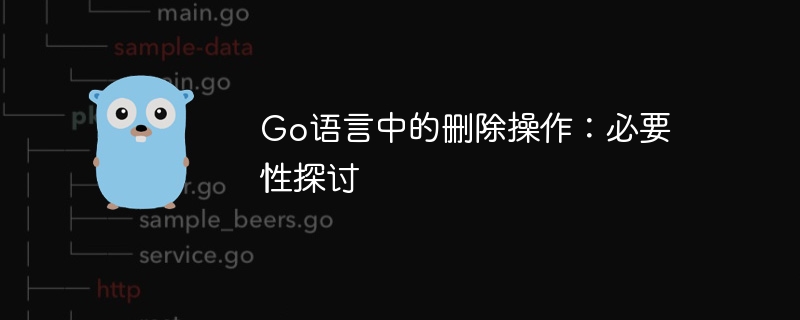Home >Backend Development >Golang >Deletion operation in Go language: discussion on necessity
Deletion operation in Go language: discussion on necessity
- WBOYWBOYWBOYWBOYWBOYWBOYWBOYWBOYWBOYWBOYWBOYWBOYWBOriginal
- 2024-03-23 08:03:041272browse

Deletion is one of the indispensable operations in any programming language, and in Go language, deletion is also a common and critical operation in the development process. This article will explore the necessity of deletion operations in the Go language and show how to implement it through specific code examples.
During the program development process, data deletion is often inevitable. Whether you are deleting records from the database or deleting elements from a slice, deletion operations are involved. In fact, in actual development, deletion operations are often more complex than addition or modification operations because it involves data rearrangement or cleaning.
Deletion operations in Go language also need to be taken seriously. When deleting data, we need to consider the following aspects:
- Data consistency: Ensure that the data deletion operation will not cause the correlation between data to be damaged.
- Performance impact: Deletion operations may affect the performance of the program, especially when deleting large amounts of data.
- Memory management: After deleting data, the memory must be released in time to avoid memory leaks.
Next, we will use specific code examples to demonstrate how to perform deletion operations in the Go language.
Example 1: Delete elements in the slice
package main
import "fmt"
func main() {
// 创建一个包含元素的切片
fruits := []string{"apple", "banana", "cherry", "date", "elderberry"}
// 找到需要删除的元素的索引
index := -1
for i, v := range fruits {
if v == "cherry" {
index = i
break
}
}
// 如果找到了需要删除的元素,执行删除操作
if index != -1 {
fruits = append(fruits[:index], fruits[index+1:]...)
}
// 输出删除元素后的结果
fmt.Println(fruits)
}In this example, we create a slice containing the names of fruits fruits, and then find the required ones by traversing the slice The index of the deleted element "cherry". Finally, use the append function to delete the element that needs to be deleted from the slice, and finally output the result after the deleted element.
Example 2: Delete key-value pairs in the map
package main
import "fmt"
func main() {
// 创建一个包含键值对的 map
scores := map[string]int{
"Alice": 90,
"Bob": 85,
"Cindy": 80,
"David": 95,
}
// 删除键为 "Bob" 的键值对
delete(scores, "Bob")
// 遍历输出删除元素后的结果
for key, value := range scores {
fmt.Println(key, ":", value)
}
}In this example, we create a map containing student grades scores, and then use The delete function deletes the key-value pair with the key "Bob", and finally traverses and outputs the result of the deleted element.
Through the above two examples, we can see that it is not complicated to implement the deletion operation in the Go language, but it is necessary to choose the appropriate method according to the specific situation. For slices, we can use the append function to delete elements; for maps, we can use the delete function to delete key-value pairs. In actual development, it is crucial to choose the appropriate deletion method according to different needs and data structures.
In general, deletion operations are also essential in the Go language. By carefully considering aspects such as data consistency, performance impact, and memory management, we can implement deletion operations more efficiently. I hope this article will help you understand the deletion operation in Go language.
The above is the detailed content of Deletion operation in Go language: discussion on necessity. For more information, please follow other related articles on the PHP Chinese website!
Related articles
See more- php each returns the current key-value pair in the array and moves the array pointer one step forward. Example
- Detailed explanation of the use of storing key-value pairs in js
- php each returns the current key-value pair in the array and moves the array pointer forward one step
- How to sort a table in descending order of columns
- How to remove JSON key-value pairs in PHP

